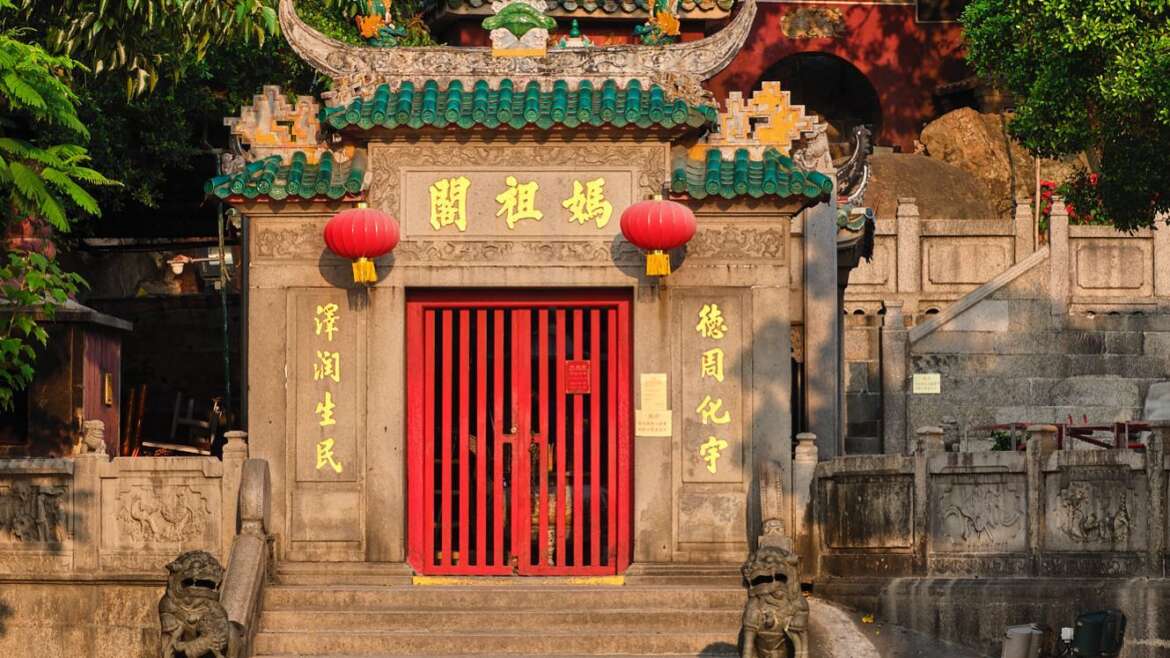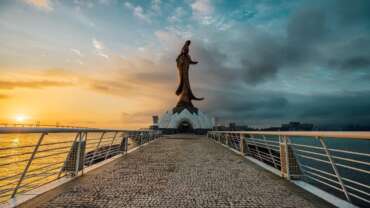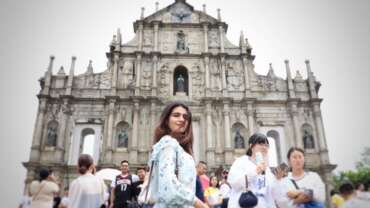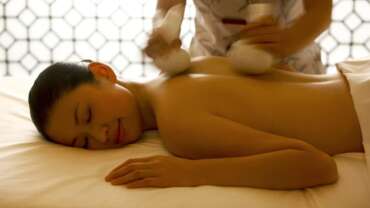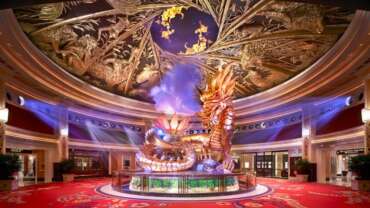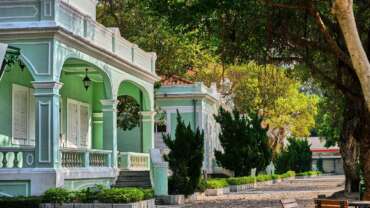Museum & Galleries in Macau
Visiting museums and exhibitions in Macao is an enjoyable, sure-fire way to make your visit more memorable and to gain more knowledge about this fascinating city and its history, plus its culture of ‘East meets West’ over the past four and a half centuries. Finding another place in the world so tiny and with such a rich cultural and historical heritage is probably next to impossible thus a variety of museums in Macao offer visitors a unique perspective on the territory’s chequered past. Professionally curated exhibitions put both traditional and modern themes under the microscope to spotlight the diversity of art and culture which nourishes the city!
Macao Museum
The Macao Museum is a historical and cultural museum with a vast number of objects of great historical value, which demonstrates the way of life and cultures of the various communities which have been inhabited the city for ages.
The first floor is a short and comparative presentation of the way western and Chinese civilizations were developed before the arrival of the Portuguese in the Pearl River Delta in the 16th century. Besides, history of Macao, commercial activities, religions and cultures of the two civilizations are also displayed. Mounting the stairs to the second floor, visitors have the opportunity to come into contact with different aspects of the popular art and traditions of Macao; such as people’s daily lives, entertainment, religious ceremonies and traditional festivals. The third floor shows contemporary Macao including the characteristic aspects of city life. The way Macao has been portrayed in literature and the arts is prominently highlighted.
The Macao Museum is located in the Mount Fortress, which was built by the Jesuits in the early 17th century. For a long time, the Fortress was the city’s principal military defence structure where public access was restricted. In 1965 this Fortress was converted into the Meteorological Services and later opened to the public. Built on top of the Mount Hill, the Mount Fortress offers a panoramic view of the city. On its west is the Ruins of St. Paul’s. On 15th July 2005, the Historic Centre of Macao was officially listed as UNESCO World Cultural Heritage. The Mount Fortress and the Ruins of St. Paul’s are significant historical monuments of the Centre.
The Macao Museum was opened on 18th April 1998, consisting of two underground levels and a third one above the fortress’ top platform where the old Meteorological Services is housed. The architectural character and special configuration of the architecture has been retained and preserved.
Mandarin’s House
Built before 1869, this was the traditional Chinese residential compound home of prominent Chinese literary figure Zheng Guanying. It is a traditional Chinese compound consisting of several courtyard houses, displaying a mix of Chinese and Western detailing, such as the use of grey bricks against arched ornamentations and Chinese timber lattice windows against mother-of-pearl window panels of Indian origin.
Maritime Museum
If the history of Macao is really connected to the sea, there is no better place for the Maritime Museum, than the Square of the Barra Pagoda, dedicated to the Taoist goddess “A-MA”, the protector of fishermen, and also believed to be the place where the Portuguese first landed. The precise spot is where the Maritime Museum is located, the building is in the shape of a sailing ship anchored in the waters of the Inner Harbour.
On the ground floor the visitor can see the traditions and the way of life of the fishermen in Macao and South China: there are several types of ships, instruments and methods of fishing, different varieties of fish and shellfish living in these waters and even a copy of a fisherman’s house, where the whole family can be seen sharing the tasks which precede or follow fishing activities.
The visitor should note the “Little A-Ma Theatre” which tells the legend of this Goddess in Cantonese, Mandarin, Portuguese and English.
The first floor is dedicated exclusively to the Great Discovery, emphasising the Maritime History of China and Portugal, since it was the sea, which brought these two civilisations together. The trips of Admiral Cheng He are shown in interactively displays. During the Ming dynasty (15th century) Cheng He charted India and Arabia from the sea and reached the Eastern coast of Africa. The routes of the Portuguese Discoveries of the 15th and 16th centuries are also presented, together with samples of the products traded from that period: tea, spices…
The second floor is dedicated to Maritime Technology and Transport and it illustrates the way Macao has been connected to the sea. Several traditional tools can be observed along side models of the latest ships, for example the jetfoils that nowadays link Macao to Hong Kong. Special attention should be given to the monitor that enables the visitor to learn about Macao’s weather, particularly during the typhoon season when the formation of these tropical storms can be observed and tracked. In addition, visitors can view a sky over the Northern Hemisphere, demonstrating the importance of astronomy in navigation. Through interactions a visitor can find different constellations, including the one representing him/herself.
On the way out the visitor will cross a gallery of aquariums showing a riverbed, the harbour waters, a coral reef and last of all the seabed with the remains if an ancient shipwreck. Outside of the museum the visitor will find several real size exhibits, among which a dragon-boat similar to those raced during the Dragon Boat Festival.
Wine Museum
This 1400 square-metre space is divided into a number of areas (Historical information/Wine Cellar/Museum and Exhibitions), using maps, texts, photos, tiles and videos, among other things to relate the history of wine. The aim of each section is not only to provide information regarding wine and grapevines, but also to recreate the atmosphere of the production of wine, showing the visitor the modern and traditional tools connected to wine production.
One of the main targets of this museum is to bring the visitor into contact with the social, economical and cultural importance of wine in Portuguese culture, traditions, daily life and celebratory rituals.
The space which houses around, 1143 different wine brands and in exposition (1115 Portuguese and 28 Chinese). From the 1115 Portuguese wine brands, there are 756 commercial wines and 359 special collection wines, and the Porto 1815 being the oldest; covers the different regions in Portugal and also presents examples of wine production in the People’s Republic of China. All varieties are accompanied by a short explanation.
There is also a set of mannequins wearing the various regional costumes from the different regions of Portugal.
Grand Prix Museum
Opened 1993 to celebrate the 40th anniversary of the Macau Grand Prix, which features a number of automobile and motorbike races and takes place every year in November. It started in 1954 due to the enthusiasm of a group of Macao residents and the support of the authorities. Today it is an international sports event that attracts thousands of tourists and racing enthusiasts to Macao, to watch the classic “Guia Race” and the “Formula 3 Grand Prix”. As it takes place on a street circuit, which inevitably leads to a comparison with Monte Carlo, the Macau Grand Prix has been developing into a race that, due to the exactness and the need for precision which it imposes on the drivers, has had the participation of great names of the motor racing participating and which has also served as a launching platform for many other names, the visitor will certainly recognise while visiting the Grand Prix Museum.
In celebration of the 50th Macau Grand Prix, the Macao Government Tourism Office has carried out extensive renovations and modernization of the Museum.
The Museum pays tribute to individuals who have made extensive contributions to the success of the Grand Prix, namely Teddy Yip, Paul Du Toit, Laurel, Ayrton Senna and John Corsmit, among others. Come and discover the Grand Prix Museum, where a collection of magnificent machines that were raced and won the Guia circuit represent the history of one of the most exciting circuits in the world.
Macao Museum of Art
The Macao Museum of Art is the only art museum in Macao and provides the largest space dedicated to visual arts.
There are 5 floors in the Museum with seven different exhibition galleries. The Gallery of Chinese Calligraphy and Paintings and Gallery of Chinese Ceramics are located on the fourth floor, where mainly Chinese Calligraphy, Paintings, and Shiwan Ceramics from Canton are exhibited. On the second and third floors there are galleries for temporary exhibitions which has on display various artist’s collections from Macao and around the world. The Gallery of Historical Pictures is also located on the third floor, including the export-orientated Western paintings and European prints of Macao’s scenery by Chinese and Western painters.
The auditorium is located on the first floor with the capacity to seat more than 100 people. It is equipped for video projections and slides and various seminars are regularly organised for the public. The Museum has a library with many art-related books and allows use of the audio facilities and internet services for free. The library is also equipped with visual facilities where the public can choose from over 400 international films to watch in its visual room. On the ground floor, there is also a workshop where various art courses are regularly organised.
Handover Gifts Museum of Macao
The Handover Gifts Museum of Macao is built on the site of the Macao Handover Ceremony of the Sino-Portuguese Governments. Now, it is the location for the exhibition of the handover gifts.
Inside, visitors can see the auspicious gifts offered by the 56 ethnics to celebrate the establishment of the Macao Special Administrative Region. These gifts were well designed with the nation’s unique artistic regional styles and represent best wishes of the ethnic groups towards Macao’s prosperous future.
Treasure of Sacred Art
The Spanish Dominicans built the Church of S. Domingos (St. Dominic’s) during the 1590s along with a convent, which unfortunately no longer exists. The church is dedicated to Our Lady of the Rosary. Initially was built of wood but during the 17th century it was replaced by an imposing structure, which included three naves. In the 18th century in line with the popular architecture of the time it was decorated in the colonial baroque style together with decorative motives characteristic of the region, a fact that contributes to its unique features.
The Museum of the Church of S. Domingos (Treasure of Sacred Art) is now located in the buildings adjacent to the church and it has been open to visitors since 1997. When the Religious Order was abolished in Portugal in 1834, the church received a great number of religious artefacts that are presently on show in the museum, which occupies what is left of the ancient cloisters and also other rooms connected to the church.
The visitor should start in the church, which was carefully restored in 1994, enabling them to somehow experience the atmosphere of ancient Catholic missions in China. Then go upstairs to the museum in order to admire the rich collection of gold objects, statues, richly ornamented canonicals, religious paintings as well as a number of liturgical vessels. Many of the pieces exhibited are from Macao but there are also some from other parts of Asia, namely India. On the whole there are around 300 excellent pieces dating from the 17th to the 19th centuries.
Treasure of Sacred Art of St. Joseph’s Seminary
Founded in 1728 by Jesuit missionaries, St. Joseph’s Seminary has cultivated numerous outstanding Catholic clergy in the course of the last three centuries, maintained a close relationship with Macao’s social development and made positive contributions to local cultural, educational, artistic and charitable undertakings.
St. Joseph’s Seminary houses a great number of religious artefacts, e.g. books and documents, oil paintings, icons, liturgical vestments and vessels, etc. In order to give the public an opportunity to appreciate these historical collections, the Cultural Affairs Bureau of the Macao SAR Government has collaborated with the Seminary and the Catholic Diocese of Macao in establishing the Treasure of Sacred Art of St. Joseph’s Seminary.
Museum of Sacred Art and Crypt
The Museum of Sacred Art and Crypt were built in the inner area of the Ruins of St. Paul’s where the magnificent church of Mater Dei had been previously located. From 1990 to 1996, the Government proceeded archaeological excavation and restoration project of the Church, and built in the location of the chancel of the ancient church, the Museum of Sacred Art and Crypt was inaugurated on 23rd October 1996.
In the centre of the Crypt, on the granite rock, lie the remains of a tomb, which might have belonged to the founder of the St. Paul’s College, Father Alexander Valignano. Along the sidewalls, there are relics of Japanese and Vietnamese martyrs.
In the room adjacent to the Crypt there is a Museum of Sacred Art, which includes objects of high historical and artistic value from different churches and convents of Macao, as well as 4 sacred paintings about St. Francis, crucifixes, religious statues and liturgical vessels, etc. Among the oil paintings, the St. Archangel Michael of the 17th century is highlighted, not only because of its antiquity and imposing figure but also it is the only work of the ancient St. Paul’s College having survived the fire in 1835.
Since the 17th century and along the centuries, Macao has been a missionary base in the Far East. The St. Paul’s College played a significant role in early religious activities. Thus the Museum of Sacred Art and Crypt, as well as the ancient Church of Mater Dei (Ruins of St. Paul’s) are remarkable historical remains reflecting the missionary work of that period.
On 15th July 2005, the Historic Centre of Macao was officially listed as UNESCO World Cultural Heritage. The Ruins of St. Paul’s are significant historical monuments of the Centre.
Lou Kau Mansion
The mansion is believed to be built in 1889.This was the home of Lou Kau, a prominent Chinese merchant who owned several imposing properties in the city. The location of this grand old house depicts the diverse social profile present in the centre of the old “Christian City”, where this traditional Chinese residence stands near Senado Square and Cathedral Square. Lou Kau Mansion is a two-storey, traditional grey-brick courtyard house, with the architectural characteristics of a typical Xiguan Chinese residential building.
Dr. Sun Yat-Sen Memorial House in Macau
This original building in the architectonic heritage of Macao houses a number of documents, paying homage to the stay of Dr. Sun Yat-Sen in Macao. He was the mentor and driving force of the Chinese republican revolution, which overthrew the weak regime of the Qing Dynasty. A charismatic personality that united the Chinese, he is therefore considered as the “Father of the Nation”. The house bears witness to his short but significant stay in Macao at the beginning of the last century when, while fleeing the power of the imperial mandarins, he tried to move his supporters in order to plan for the establishment of a new regime in China. In Macao he received the support of friends, at the time important and powerful persons in political and social of Macao.
Lin Zexu Memorial Museum of Macao
This small museum is located near the Lin Fong Temple and commemorates the visit of the imperial commissioner Lin Zexu to Macao on the 3rd September 1839 (during the reign of Emperor Daoguang). The aim of the visit was to ensure both the prohibition of the opium trade in the Territory administered by the Portuguese authorities and the Portuguese neutrality in the differences that opposed Great Britain to China and, which would lead to the Opium War. This war would result in the opening of a number of Chinese ports to the international commerce and to the cession of Hong Kong Island to the British.
This museum has a photographic display bearing witness to that highly tense period in the history of China.
Xian Xinghai Memorial Museum
Xian Xinghai is hailed as “the people’s musician” and is renowned for his great achievements in the contemporary music history of China. Born into a fishing family in Macao, he meticulously sought for musical excellence, ingeniously integrated Chinese and Western music techniques and created many well-known masterpieces over his brief 40 years, all brimming with the cultural inclusiveness of Macao. One of his signature pieces, the Yellow River Cantata, was widely sung during the War of Resistance against Japanese Aggression, where it boosted the morale and stimulated patriotism of the Chinese across the nation.
In celebration of the 70th anniversary of the founding of the People’s Republic of China and the 20th anniversary of the Macao’s Handover to China, the Macao SAR Government has established the Xian Xinghai Memorial Museum to honour his contributions to the nation, promote his musical achievements and set him as role model for the young people.
Fire Services Museum
The Fire Services Museum Building was built in 1920 in European style, with more than 700 exhibits in two halls occupying an area of 350 square meters. In the main hall there are Chinese and British made pumps, old British fire engines, a display showing a fireman sliding down a pole, data, historic pictures and shield, flags, diplomas, medals and badges of the brigade. There is also a mannequin dressed in a 1940’s ceremonial uniform.
The second hall shows a more face of the brigade where there are a model of the Central Operational Post, an electronic board indicating the sites of current and past fire stations, a helmet and boots, traditional Chinese hoses and nozzles, ancient fire alarms, the plaque with the word well ladders, the breathing apparatus and public fire hydrants. There is also a model simulating the effect of fire on a wooden hut.
Museum of the Holy House of Mercy
The Holy House of Mercy Museum, which was opened in 2001, comprises an invaluable collection of Macao’s Catholic relics, some of them dated back from 16th Century, bearing testimony to the history of Western culture that was introduced to China through Macao.
Here, lies items connected to the history of the Holy House itself, with natural emphasis for the original manuscript of the Commitment of the Macau Holy House of Mercy handwritten and dated of 1662, believed to be the oldest in the Holy House of Mercy’s archives, institution founded some years earlier, in 1569 by the first Bishop of Macao, D. Belchior Carneiro.
Other relevant pieces of secular history of the Holy House of Mercy are: the Skull D. Belchior Carneiro and the Cross that he was buried with; the oil portrait of D. Belchior Carneiro, dating from the 18th century; and the bronze bell from the old S. Rafael Hospital.
Another feature of the museum are the pieces of Sacred Art among which stand out: the statue of the Sacred Heart of Jesus dated from the early 19th century, the statues of Our Lady of the Annunciation and Crucified Christ, both in ivory and dated from 18th century, Japanese and European ceramics with the monogram of the Society of Jesus, demonstrating the key role played by the Jesuits in the rapprochement between the Eastern and western civilizations.
Natural and Agrarian Museum
Located in the Seac Pai Van Park of Coloane, the Natural and Agrarian Museum is the first museum of nature in Coloane Island dedicated to showcases of natural resources. It was opened to the public on 21st March, 1997. Each of the two exhibition halls of the Museum has two display areas housing a collection of around 200 exhibits under the following themes on Macao: physical geography, Mangal artificial, specimens of flora and fauna.
Sound of the Century – The Museum of Vintage Sound Machines
The Museum boosts a collection of over 200 pieces of authentic historical audio and visual equipment : antique gramophones and phonographs, hand-cranked music boxes, manual telephones, tube radios, carved cashiers, wire recorders, televisions and coin-operated juke boxes that date back from as far as more than one hundred years ago. Come and experience the visual and operatic beauty of original records and cylinders playing on the original talking machines. Take yourself back in time and marvel at the magic and wonder of an earlier world of music powered by springs to the development of modern day electronics.
Museum of the Macao Security Forces
Located next to the S. Francisco Garden (Calçada dos Quartéis S. Francisco), exhibits military equipment and introducing Macao Police Force history.
Macao Tea Culture House
The Macao Tea Culture House – an imposing edifice featuring southern European elements and a Chinese tiled roof – complements the Portuguese-style buildings in the area magnificently as well as the surrounding Suzhou-inspired landscape of Lou Lim Ieoc Garden.
This new attraction will stage a variety of long and short-term exhibitions to introduce the tea cultures of Macao, China and the West, and seeks to promote the study of tea cultures worldwide.
Museum of Taipa and Coloane History
A comprehensive collection of exhibits are displayed at the museum. On the first floor, the exhibitions of the historical relics unearthed on Coloane, the stone architectural remains in the basement of the former Island Council Building, and the development of the villages, religions and culture of the islands provide an overview of the history and culture of old Coloane and Taipa. The exhibition rooms on the second floor have different themes, including the history of the former Municipal Council of the Islands, a look back at agriculture and handicrafts in the old days, the architectural features of buildings on Coloane and Taipa and the recent development of the two islands. It provides visitors with a better understanding of the modern political and economical development of Coloane and Taipa.
General Ye Ting’s Former Residence
The late General Ye Ting, a prominent military leader and one of the pioneers for the Chinese People’s Liberation Army, had spent seven years living in Macao. In commemoration of his significant role in China’s modern history, the Macao SAR Government has carried out a series of restoration projects on Ye’s former residence in Macao since 2006, raised bronze sculpture at the front yard and installed photo exhibitions in the mansion. General Ye Ting’s Former Residence was officially opened to the public on 28 May 2014.
The two-storey, western-style mansion occupies some 180 square meters together with its front yard. Entering the Former Residence, visitors can find the mansion furnished with numerous pieces of its original furniture and home decorations from the old days. Housing a display of antique photos, General Ye Ting’s Former Residence bears witness to Ye Ting’s life in Macao with his family in the bygone years.
Tung Sin Tong Historical Archive Exhibition Hall
Established in 1892, Tung Sin Tong Charitable Society was the first such Chinese charitable organization in Macao, and is the only one in China to have provided an uninterrupted service since its inception. From its humble origins of providing food, clothing and medicine to the poor, it has grown into a sizeable institution that today operates nurseries, a primary and secondary school, an adult-education centre, medical clinics and pharmacy, and dispenses rice and cooking oil to the needy. Learn more about this inspiring institution – and the people of Macao – in the Archive Exhibition Hall.
Commemorative Gallery of the Macao Basic Law
The Basic Law of the Macao Special Administrative Region is formulated in accordance with the Constitution of the People’s Republic of China, safeguarding state sovereignty and territorial integrity on the one hand and granting Macao a high degree of autonomy on the other hand. It is a manifestation of the guiding principle of One Country, Two Systems and the Central Government’s basic policies towards Macao. The formulation of the Basic Law is deeply rooted in history and of momentous practical significance.
The Commemorative Gallery of the Macao Basic Law has shouldered the responsibilities to preserve the historical traces and ensures that future generations will be aware of this process and the underlying reasons. In the gallery, the following exhibition zones are set up: “Foreword”, “Retrospective History of Macao”, “The Guiding Principle of One Country, Two Systems”, “Formulation and Implementation of the Macao Basic Law”, “The Constitution of the People’s Republic of China and the Macao Basic Law”, “Success of the Macao Basic Law”, “Promotion of the Macao Basic Law” and “Interactive Education Zone”. In addition, there is an archive which aims to provide valuable documents for the researchers or interested parties so that they can gain a better understanding of the relevant materials and the basic spirit of the Macao Basic Law, as well as how it has been implemented successfully in Macao.
Tap Seac Gallery
An exciting gallery devoted to promoting both cultural and artistic exhibitions has been opened in Macao on 5th Dec. 2003. The Tap Seac Gallery, which is being financed and managed by the Cultural Institute, is available for presentations, educational projects and research projects, expositions and other functions.
Tap Seac Gallery features distinctive design and construction having two wells inside the building, plus a patio in the centre of the building which allows in daylight to add a unique dimension to exhibitions and displays. The gallery covers 4,000 square feet, and for multi-purpose usage, the interior signboards can easily be adjusted and moved around. In addition, there are some computer stations allowing access to the Internet as a further aid for cultural research and information.



